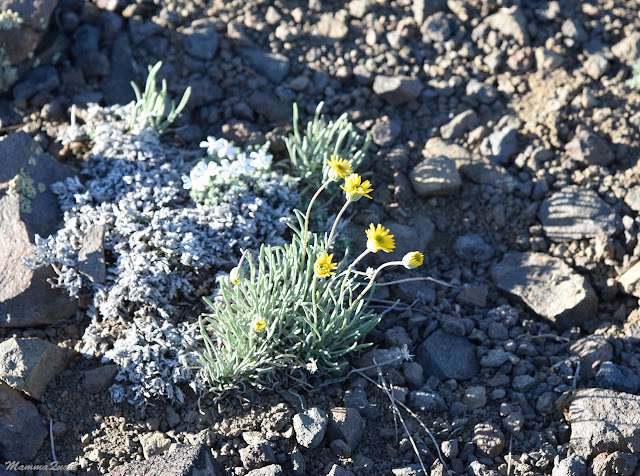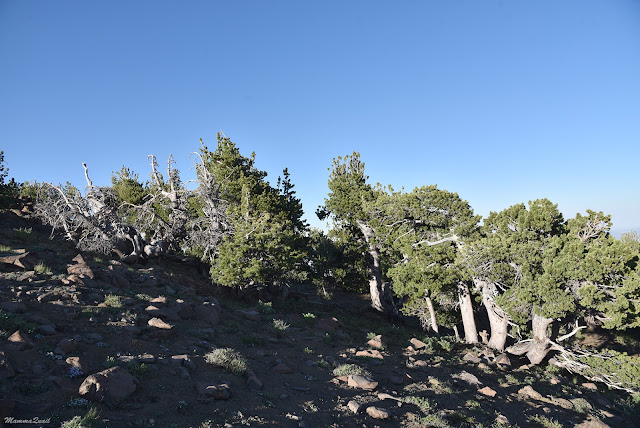 |
| Patterson Lake |
Date: July 3, 2017
Place: South Warner Wilderness, Alturas, California
Coordinates (of Pine Creek Basin): 41.362254, -120.243023
Length: 2.5 miles
Level: strenuous
We passed our first night at our quiet knack if the woods at the Pine Creek Basin. Yesterday's hike wasn't much of an exercise but today we were looking at a good 2000" elevation gain going up to Patterson Lake.
We woke up early but took our time getting ready. It was still before sunrise when I went to the creek to get water, getting my feet wet in the morning dew and enjoying the early wildflowers.
 |
| Houndstongue, Hackelia micrantha |
 |
| Nodding Microceris, Microseris nutans |
About a third of a mile later we exited the conifer forest and started going up a bright green slope, interchanging open grass and shrub areas and bright aspen groves. We stopped at the first aspen grove to get our mosquito repellant out for we were being eaten alive.
It didn't take long before we also left the aspen groves behind and were walking through a low chaparral area that was so green and lush, looking very different than the chaparral I was familiar with from the Bay Area.
Out in the sunlight there was a spectacular display of wildflowers. While all the colors of the rainbow were represented, the blues dominated the scene.
Thick clusters of lupine and larkspur in dazzling blue were splashed on the mountainside, rendering it a work of art far superior to any human creation. I slowly walked through the splendid display, intoxicated by the young spring air.
 |
| Meadow Larkspur, Delphinium nuttallianum |
 |
| Few-flowered Blue-eyed Mary, Collinsia parviflora |
 |
| Mountain Mule Ears, Wyethia mollis |
 |
| Going up Pine Creek Basin |
 |
| Mountain Fritillary, Fritillaria atropurpurea |
 |
| Horsemint, Agastache urticifolia |
And in the far horizon, high above everything, floated Mount Shasta, its snow-capped cone like an apparition in the hazy hot air.
 |
| Surprise Valley |
 |
| Ballhead Waterleaf, Hydrophyllum capitatum |
 |
| Sticky Geranium, Geranium viscosissimum |
 |
| Low Phacelia, Phacelia humilis |
We were getting closer and closer to the patches of snow. The elder chika kept wishing of a snow patch closer to the trail where she could cool off. It would not be long now.
As we gained more altitude the vegetation also altered. The shrubs were smaller and the trees were smaller and more of them were alone rather than in groves.
And we saw different wildflowers too.
 |
| Spreading Phlox, Phlox diffusa |
The trail became steeper. Not much, but enough to slow us down. We could also see more exposed rocks, free of vegetation. It was in these places where the volcanic past of the region was most apparent.
Eventually we arrived at the ridge and the trail leveled. At that point I was at the lead, anxious to get to the intersection with the Summit Trail. I could already see glimpses of the view east of the ridge, enough to tell it was breathtaking. I also enjoyed the changing display of wildflowers high up on the ridge.
The trees up there were all Alpine dwarf pines that reminded me very much of the ancient bristlecone pines we've seen at the White Mountains. The similarity isn't coincidental nor completely convergent: the alpine pine is the closest relative of the bristlecone pine, and both species grow in high altitudes.
We arrived at the intersection and sat down beneath a small alpine pine that cast just enough shade for Pappa Quail and the chikas.
 |
| Alpine Pine, Pinus albicaulis |
A large snow patch nearby attracted the chikas and soon they were on the snow.
 |
| Snow Woman |
 |
| Eaton's Daisy, Erigeron eatonii |
 |
| Broadstemmed Onion, Allium platycaule |
I wasn't the only one enjoying the bloom. Butterflies were numerous, and very active. I was lucky when occasionally one would stay put long enough to be photographed.
 |
| Milbert's Tortoiseshell |
I didn't think it was possible but the Summit Trail turned to be even more beautiful than the Pine Creek Trail we hiked earlier that day. The stunning view both east and west gave us the feeling of being on top of the world.
 |
| Silvery Lupine, Lupinus argenteus |
 |
| Common Woolly Sunflower, Eriophyllum lanatum |
Once again I lingered behind to try and capture this beauty on camera.
Pappa Quail also was looking for flying things, but of the feathered kind.
 |
| House Wren (adult, western) |
The problem turned out to be a large snow field that covered the trail ahead of us, blocking our way up to Patterson Lake.
The snow patch covered maybe 50 meters of trail but the difficulty wasn't in the length but in its location on a very steep slope. Even if we had crampons and ice axes I'm not sure we would have risked crossing it, certainly not with children. But we had no snow equipment with us (they said the trails were clear when I called!) so crossing the snow field was not an option.
We probably should have turned around at that point. But being so close to our destination we decided to bypass the snow and chose to go above it. I'll make the long story short - we did it, but got very close to disaster. I still shudder when I think of it.
The elder chika had the least trouble - she went ahead like a mountain goat. The younger chika was petrified and as Pappa Quail clambered slowly on the steep rocky slope she refused to budge. I managed to encourage her to progress a bit, but then got cold feet myself and decided to take her higher. Pappa Quail went ahead while me and the younger chika tried to find a better route a bit higher up the slope. We made some progress when I heard a shout and saw Pappa Quail sliding fast down the snow patch. He had slipped on a mud spot and ended up going down on his butt down to and through the snow. Fortunately he was stopped by the trail which at that place was already clear of the snow. His backpack, which he held by hand, came loose and continued sliding all the way down to the bottom of the snow field, and a good distance further.
My heart was racing. I had to force myself to move on, for there was no way of going back where we were. I slowly directed the younger chika to move carefully from a rock to a bush to a rock, gripping tightly to anything she could hold. I did the same, but I also had to move both my backpack and hers with each move. We ware making progress at an inchworm pace.
Meanwhile Pappa Quail found a way down and retrieved his backpack. As he made it back to the trail and rested his pack near the elder chika I lost my grip on my pack and that wend a-sliding down, coming to a rest at a point even further than Pappa Quail's has.
The younger chika kept on moving slowly, and I followed her, dragging her backpack with me. As we made our way down Pappa Quail did a second trip down the slope to retrieve my backpack.
 |
| Productive Clover, Trifolium productum |
 |
| Sticky Geranium, Geranium viscosissimum |
 |
| Hoodoos |
Patterson Lake is located in the most beautiful place, nestled inside the horseshoe ridge of Warren Peak with a steep slope to the east and a narrow strip of flat area where people camp when they go up there. We saw the lake below us, still mostly frozen. But the trail leading down to it could not be seen. It was buried under a large snow field, bigger and steeper than the one we had just crossed at a great risk.
 |
| Patterson Lake |
Pappa Quail was exhausted. He took some time to rest, then slowly pitched our tent and had it prepped for sleeping. Meanwhile I worked the chikas in collecting twigs from the downed and dry trees of which there were plenty, and started our Biolite stove. We had no source of water there, not in a liquid form, so we needed to melt snow, and that takes much time and energy. We had our work cut out for us.
Being busy with my work didn't prevent me from seeing that this place we were going to spend the night at was full of wildflowers. Small, low to the ground, hardy, and very beautiful.
Moving about the lace I even managed to snap a few shots between my chores.
 |
| Douglas' Phlox, Phlox douglasii |
 |
| Royal Beardtongue, Penstemon speciosus |
 |
| A view northeast from our campsite above Patterson Lake |
The local plants are well adapted to this weather.
 |
| Desert Yellow Fleabane, Erigeron linearis |
 |
| Clumping Buckwheat, Eriogonum caespitosum |
The sun had still some way to go when we finished our dinner. It didn't take long before Pappa Quail and the chikas vanished inside the tent. They were cold and tired, and the desolation had gotten into them.
I remained outside to wash the dishes, melt some more snow into drinking water, and to wait for the sunset.
It was too cold to stay put so I walked around a bit, scouting for a possible way down to the lake or an alternative way back to where we came from. It was too late to find any clear paths to either direction, but I got some leads that looked promising and decided to explore them further on the morrow.
 |
| The last light on the snow |
Cold and tired yet strangely exhilarated I crept into the tent and cocooned myself inside my sleeping bag. And although I had no idea yet of how we were going to get out of there, I pushed my worries out of my mind and crushed into sleep.
Many thanks to members of the California Native Plants Society for their help in identifying plants!























The views and flowers are magnificent, but the stor is very frightning...
ReplyDeleteWell, we pulled through. Now we know better. And I would love to go back there sometime to complete this hike and get to the lake :-)
Delete